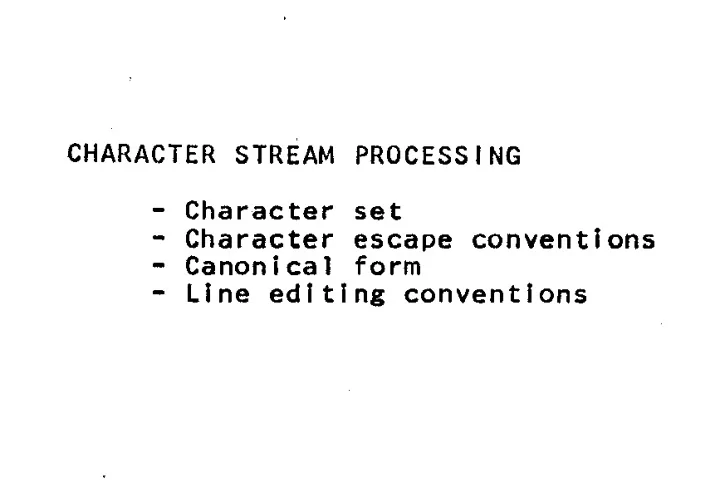

CHARACTER STREAM PROCESSING - Character set - Character escape conventions - Canonical form - Line editing conventions
CHARACTER SET CONSIDERATIONS minimum: graphic range equal to a typical office typewriter support: throughout system -programs and data files program language literals symbolic file names symbolic subroutine linkage punched cards typewriters and displays printers
CHARACTER STREAM PROCESSING CONSIDERATIONS 1. Device Independence--any program with any terminal, 2. Unambiguous relation between printed image and stored string.
non-e~nonlcal EXAMPLE OF DEVICE INDEPENDENT, UNAMBIGUOUS CHARACTER SET SUPPORT stored ASCII flies edltln& character s User Procr am 1-1~ Supervisor Subroutine EBCDIC non-canonical escapes for ASCII codes edltln& characters Llnslde: ASCII canonical for m no unlnterpreted edltlnc or escape characters
ESCAPE CONVENTIONS FOR DEVICE INDEPENDENCE Typed at 2741 terminal: y = board_position <i,j >; Character string passed to program: y = board_position l,j ;
CANONICAL REDUCTION EXAMPLE (user) locate "order" 1. ( edItor) the order has been f i I ed. 2. (user) .!1." 3. change "1." to II 4. (edl tor) the order has been f i J ] !i:d •
CANONICAL REDUCTION METHOD typed: f.Qr. that stored: 1. Graphics typed in the same column are In ASCU collating sequence, separated by backspaces. 2. White space is represented by ASCII "blank" characters regardless of how typed.
Ll NE AND PRINT POSITION ED I Tl NG y = lenz#gth(string4); 1. typed: y • length(strlng4); stored: typed: Silncer@Sincerly## yours, 2. stored: Sincerely yours, typed: we have ~#U#.liQ 1 eft. 3. we have .lllQ left. stored:
OBSERVATIONS FROM USAGE -Economically implementable - Effective human interface - User can Ignore special features until needed - Interaction between canonical form and horizontal tabulation
Recommend
More recommend